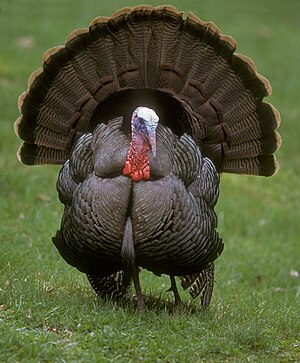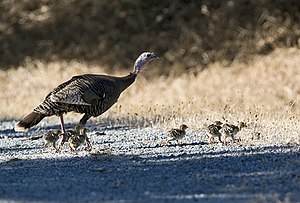 Image via WikipediaThe Wild Turkey (Meleagris gallopavo), the heaviest member of the Galliformes, is fairly common now. However due to habitat loss and over-hunting, turkeys were once on the way to extinction until conservation organizations were established to preserve and expand their populations. Today wild turkeys live across most of the U.S. and their numbers have risen to more than 7 million.
Image via WikipediaThe Wild Turkey (Meleagris gallopavo), the heaviest member of the Galliformes, is fairly common now. However due to habitat loss and over-hunting, turkeys were once on the way to extinction until conservation organizations were established to preserve and expand their populations. Today wild turkeys live across most of the U.S. and their numbers have risen to more than 7 million.The average life expectancy for wild turkeys is one and a half years in the wild and 13 years in captivity. Besides hunters, the birds are prey to a variety of animals like raccoons, bobcats, foxes, eagles, owls and much more.
The turkey is covered by about 6,000 iridescence feathers of varying colors of red, green, copper, bronze and gold. The gobbler, or male turkey, is more colorful, while the hen is a duller color to camouflage her with her surroundings.
 Image via Wikipedia Image via Wikipedia |
| Female Wild Turkey with 8 chicks |
According to Wikipedia there are six subspecies:
Eastern Wild Turkey (Meleagris gallopavo silvestris)- The most common and seen by the fist pilgrims.
Osceola Wild Turkey or Florida Wild Turkey (M. g. osceola) There are about 80,000 birds in Florida named after the Seminole Chief Osceola in 1890. It is smaller and darker than our Eastern Wild Turkey.
Rio Grande Wild Turkey (M. g. intermedia) More of a prairie bird, this sub-species is native to the central plain states. First described in 1879, they have longer legs for running and the back feathers are a buff-very light tan color.
Merriam's Wild Turkey (M. g. merriami) A western bird with purple and bronze reflections that ranges through the Rocky Mountains and the prairies of Wyoming, Montana and South Dakota as well as much of the high mesa country of New Mexico. It was named in 1900 in honor of Clinton Hart Merriam, the first chief of the U.S. Biological Survey.
Gould's Wild Turkey (M. g. mexicana) They exist in small numbers in the U.S. but are abundant in Northwestern portions of Mexico. A small population has been established in southern Arizona. Gould's are the largest of the five sub-species. They have longer legs, larger feet, and longer tail feathers. The main colors of the body feathers are copper and greenish-gold. This subspecies is heavily protected owing to its skittish nature and threatened status.
South Mexican Wild Turkey (M. g. gallopavo) The nominate subspecies, and the only one that is not found in the United States or Canada. The Aztecs domesticated the southern Mexican sub-species, M. g. mexicana, giving rise to the domestic turkey. The Spaniards brought this tamed subspecies back to Europe with them in the mid-16th century and from Spain it spread to France and later Britain as a farmyard animal, usually becoming the centerpiece of a feast for the well-to-do. By 1620 it was common enough so that Pilgrim settlers of Massachusetts could bring turkeys with them from England, unknowing it had a larger close relative already occupying the forests of Massachusetts. It is one of the smallest subspecies and is best known in Spanish from its Aztec-derived name, guajolote. Thought to be critically endangered as of 2010.
Related articles:
What do Turkeys Eat?
Why is a Turkey Is Called a Turkey?

Category ›
Bird of the week
 Unknown
Unknown
 Sunday, November 21, 2010
Sunday, November 21, 2010









No comments:
Post a Comment